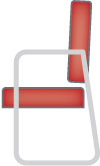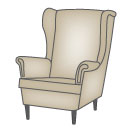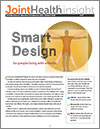In this issue
Listening to you Arthritis Consumer Experts (ACE)
JointHealth™ insight Published August 2018

In this issue of JointHealth™ insight, we look at how smart choices in our living environments can make our arthritis experience easier, safer, and less painful.
The kinds of challenges faced by people with arthritis differ based on type of disease and level of joint damage, pain, and stiffness. Thoughtful planning is useful for everyone; however, as we age, convenience and ease of use become more and more valuable.
Today, home design experts promote the concept of “universal design”, the practice of making a home as safe and accessible as possible for people who face challenges due to aging or disability. These principles can be useful for anyone who is designing or renovating a home, as they can increase home value and eliminate the need for costly retrofitting down the road.
Outside your home, navigating the outside world can be a daily challenge for people with arthritis. Everything from driving a car to waiting in line at the post office can be affected by joint pain and stiffness. Here again, smart design and planning has helped with ease of mobility.
When it comes to employment and the workplace, arthritis and related bone and joint diseases are the most common cause of work disability in Canada. Employers collaborating closely with their employees living with arthritis have access to many job accommodations and other solutions to help employees overcome challenges in the work environment.
Around the house
Bedroom
Dressing
Kitchen
Bathroom
Laundry Room
Dining Room
Living room
Foyer
Researchers at Arthritis Research Canada have shown that workers with arthritis, who have more flexible work arrangements and have received job accommodations, are more productive at work and less likely to become work disabled. In fact, in an Arthritis Consumer Experts survey, our members ranked flexible work arrangements as the most important strategy that was helpful for maintaining employment.
While implementing changes in the work environment for employees living with arthritis, we must not overlook the real need for culture change in the workplace. The goal of creating more flexible and accommodating workplaces won’t be achieved unless we change how people think about arthritis and workplace accommodations. Employers and employees need to understand that for workers with arthritis, the struggle involves balancing their workplace responsibilities with the challenge of managing their disease including symptoms such as pain, fatigue, and stiffness, often with a gradual loss of physical function.
Although it may be difficult to control some aspects of your work environment, ACE recommends below some strategies that can be used, and simple modifications that can be made to make working with arthritis easier.
Desk
Work Schedule
Awareness in the work place
As much as you are comfortable, educate your coworkers and employers. Many people do not understand what it means to have inflammatory arthritis. Fatigue can be misinterpreted as laziness; unpredictable flares may be seen as a lack of reliability and physical limitations can be ignored or resented by coworkers and employers. Only education can change these attitudes.
It is entirely up to you whether you chose to disclose your disease, but open communications with your workplace may lead to less stress and anxiety about missing work due to active disease down the road. Learn about the Canada’s Best Work Places for Employees Living with Arthritis Program.
Listening to you
We hope you find this information of use. Please tell us what you think by writing to us or emailing us at feedback@jointhealth.org. Through your ongoing and active participation, ACE can make its work more relevant to all Canadians living with arthritis.
Update your email or postal address
Please let us know of any changes by contacting ACE at feedback@jointhealth.org. This will ensure that you continue to receive your free email or print copy of JointHealth™ insight.
Arthritis Consumer Experts (ACE)
Who We Are
Arthritis Consumer Experts (ACE) provides research-based education, advocacy training, advocacy leadership and information to Canadians with arthritis. We help empower people living with all forms of arthritis to take control of their disease and to take action in healthcare and research decision making. ACE activities are guided by its members and led by people with arthritis, leading medical professionals and the ACE Advisory Board. To learn more about ACE, visit: www.jointhealth.org
Acknowledgements
Over the past 12 months, ACE received grants-in-aid from: Amgen Canada, Arthritis Research Canada, AstraZeneca Canada, Canadian Biosimilars Forum, Canadian Institutes of Health Research, Celgene, Eli Lilly Canada, Hoffman-La Roche Canada Ltd., Merck Canada, Novartis Canada, Pfizer Canada, Sandoz Canada, Sanofi Canada, St. Paul’s Hospital (Vancouver), UCB Canada, and the University of British Columbia.
ACE also receives unsolicited donations from its community members (people with arthritis) across Canada.
ACE thanks funders for their support to help the nearly 6 million Canadians living with osteoarthritis, rheumatoid arthritis, psoriatic arthritis, ankylosing spondylitis and the many other forms of the disease. ACE assures its members, academic and healthcare professional collaborators, government and the public that the work of ACE is free from influence of its funders.
Disclaimer
The material contained on this website is provided for general information only. This website should not be relied on to suggest a course of treatment for a particular individual or as a substitute for consultation with qualified health professionals who are familiar with your individual medical needs. Should you have any healthcare related questions, you should contact your physician. You should never disregard medical advice or delay in seeking it because of something you have read on this or any website.
This site may provide links to other Internet sites only for the convenience of World Wide Web users. ACE is not responsible for the availability or content of these external sites, nor does ACE endorse, warrant or guarantee the products, services or information described or offered at these other Internet sites.
Although the information presented on this website is believed to be accurate at the time it is posted, this website could include inaccuracies, typographical errors or out-of-date information. This website may be changed at any time without prior notice.

The kinds of challenges faced by people with arthritis differ based on type of disease and level of joint damage, pain, and stiffness. Thoughtful planning is useful for everyone; however, as we age, convenience and ease of use become more and more valuable.
Today, home design experts promote the concept of “universal design”, the practice of making a home as safe and accessible as possible for people who face challenges due to aging or disability. These principles can be useful for anyone who is designing or renovating a home, as they can increase home value and eliminate the need for costly retrofitting down the road.
Outside your home, navigating the outside world can be a daily challenge for people with arthritis. Everything from driving a car to waiting in line at the post office can be affected by joint pain and stiffness. Here again, smart design and planning has helped with ease of mobility.
When it comes to employment and the workplace, arthritis and related bone and joint diseases are the most common cause of work disability in Canada. Employers collaborating closely with their employees living with arthritis have access to many job accommodations and other solutions to help employees overcome challenges in the work environment.
For people who live with arthritis, these solutions at home or at work can take some of the pain and difficulty out of living with disease. We have categorized our smart design “fixes” into 3 groups, so you can quickly find those that are most relevant to you:
| Little fix: simple solutions that require minimal time and money |
|
| Moderate fix: solutions that may require some time, money or additional resources |
|
| Big fix: solutions that will work best for those renovating, designing a new home, or considering a big purchase |
 |
At Home In nearly every room in the house, simple, good design can make life easier every day for people with arthritis. Whether disease affects your hands, back, knees, or other joints, re-thinking the way your home is set up can relieve pain and protect your independence, whether you are elder, middle aged or young |
Around the house
| When searching for a new home or apartment, look for houses or apartments with frequently used rooms on the main floor. For example, having the master bedroom, kitchen, and living room on the main floor eliminates the need to climb stairs multiple times per day. As an alternative, eliminate stairs entirely with a one-floor house or apartment. | |
| Softer flooring is usually easier on the feet and knees than hard materials, like tile or concrete. Consider carpeting or cork flooring as an alternative to harder materials. | |
| Lever-style door knobs are much easier on the hands and wrists than round knobs, which require gripping and twisting. | |
 | |
| Curtains on large rings slide easily open and shut, and are often more comfortable to maneuver than blinds with cords. | |
| Install railings on both sides of stairs to make climbing and descending easier and safer. | |
Bedroom
| The easiest bed to get out of in the morning is one that is fairly firm and raised off the floor by 18”- 21”. | |
| Consider buying an alarm clock that you can turn off by pressing a large button or tab, as opposed to one requiring squeezing or turning small buttons with the tip of your thumb and index finger. | |
| “Slip-on” slippers are much easier to put on than full shoe-style slippers. | |
 | |
Dressing
| Knit shirts and sweaters that can slip on over your head eliminate the need to contend with buttons or zippers. | |
| For women, a one-piece sports-style brassiere may be easier to put on and take off than one with the traditional hookand-eye closures. | |
| A long-handled shoe-horn can be very useful when putting on or taking off shoes. | |
| Pants with an elastic waist may be easier to pull on and off. |
Kitchen
| Consider changing cabinet door and drawer pulls to “cup” or “u-shaped” pulls. These allow the use of the whole hand to open drawers and cabinets, as opposed to small knobs that require grabbing with fingers. Alternatively, consider open shelving with no doors at all. | |
| Keeping bowls and plates in large drawers, as opposed to upper cabinets, eliminates the need for reaching upwards which may reduce strain on back and shoulders. | |
| Regularly-used items like breakfast cereal can be kept right under the counter, as opposed to on the lowest shelf, to minimize bending and crouching. | |
| When buying a new refrigerator, consider one with a bottom-mount freezer. This puts the things we are more likely to use every day, like fresh foods and beverages, at eye level and means less stooping and crouching. | |
 | |
| Dishwasher drawers, as opposed to conventional dishwashers, can be much more easily loaded and lessen the need to bend or crouch. | |
| Find a place on the counter, if possible, for small appliances like your toaster and mixer to avoid extra lifting. | |
| Pots and pans should ideally have two handles, and handles should be large enough to slide your whole hand or arms under for lifting. |
|
 | |
| Kitchen tools like knives and peelers should have large, softer handles to make them easier to hold. You can buy rubber grips that can be attached to the preexisting handles. | |
| Standing on a commercial-grade rubber mat can lessen pressure and strain on feet and knees. People who have to stand for long periods of time, like factory workers and grocery check-out cashiers, have been using these for years. | |
Bathroom
| Wall mounted low-flush style toilets can eliminate the need to get down on hands and knees to clean behind the toilet. As well, they can be mounted slightly higher than conventional toilets which can make it easier to sit down and get back up. | |
 | |
| Grab-bars beside the toilet and around the tub and shower can be very helpful. For people building a home or doing a renovation who don’t need them yet, walls can be reinforced beside the toilet to make bars easier to install if and when they become necessary. | |
| Lever style faucets for the sink, bath, and shower automatically mix both hot and cold water and eliminate the need for grabbing and twisting conventional taps. | |
| Consider adding non-slip strips at the bottom of both bath and shower. | |
Laundry Room
| Front-loading washers are often easier to load and unload than top-loaders, as they do not require as much bending, leaning, and lifting. | |
 | |
| Smaller detergent bottles are much easier to handle than the larger, heavier bottles. If your preferred detergent comes in a large-sized bottle, consider asking a family member or friend to decant it into smaller containers. | |
| Installing a laundry chute is a great way to lessen the need to carry large, heavy laundry baskets up and down stairs in multi-storey houses. | |
Dining Room
| Sled-style chairs glide on wood floors or carpets and are easier to pull out and push in than four legged chairs. | |
 | |
| Dining chairs with arms can make it easier to stand up and reduce pressure on the knees. | |
| Cutlery with a larger, rounded handle can be easier to grip. | |
Living room
| Higher, firmer sofas and chairs are easier to get on and off; ideal seat height is 16”-18” for sofas. | |
 | |
| When purchasing chairs, consider this: it is easier to get out of a seating position if you can slide your feet a little under the seat and push yourself off using the arms which extend a bit further than the front of the seat. | |
| Switches for table lamps and floor lamps can often be very small and stiff, and require difficult pinching and turning. Consider finding lamps with switches that you can operate by pressing a button with your foot. | |
| Placement of a television is very important. The optimal position is one that allows the viewer to watch without tilting the head upwards. Keeping the television on a low bench provides the optimal positioning. | |
| Coffee tables should not be lower than seat height. | |
Foyer
| Retrofitting house keys with large plastic ends provides a larger surface area and makes locking and unlocking the doors easier on fingers. | |
 | |
| Thumb-turn style bolts are easier to use than other locking mechanisms that require pinching and twisting with your thumb and forefinger. | |
| A coat rack or hooks on the wall may be easier and more convenient than fiddling with hangers and closet doors. | |
 |
At Work |
Researchers at Arthritis Research Canada have shown that workers with arthritis, who have more flexible work arrangements and have received job accommodations, are more productive at work and less likely to become work disabled. In fact, in an Arthritis Consumer Experts survey, our members ranked flexible work arrangements as the most important strategy that was helpful for maintaining employment.
While implementing changes in the work environment for employees living with arthritis, we must not overlook the real need for culture change in the workplace. The goal of creating more flexible and accommodating workplaces won’t be achieved unless we change how people think about arthritis and workplace accommodations. Employers and employees need to understand that for workers with arthritis, the struggle involves balancing their workplace responsibilities with the challenge of managing their disease including symptoms such as pain, fatigue, and stiffness, often with a gradual loss of physical function.
Although it may be difficult to control some aspects of your work environment, ACE recommends below some strategies that can be used, and simple modifications that can be made to make working with arthritis easier.
Desk
| When seated at a desk, your legs should be at a 90-degree angle to your body, and your thighs should be parallel to the ground. | |
 | |
| A good office chair positioned at the right height relative to the desk surface is very important. Look for a chair with adjustable height and good lower back support | |
| If you are unable to get a chair with good back support, try a cylindrical pillow, or make that shape with a rolled-up towel, to support your lower back | |
| For shorter people, a footrest is often a great idea to make sure that feet are able to sit firmly on the ground. A makeshift footrest can even be made by duct taping phone books together to the right thickness | |
| Computer screens should be at a height to allow you to look straight ahead, and not up or down. You may be able to fix this by adjusting the height of your desk | |
| A good desk lamp allows for better posture, as it often eliminates the need for stooping. It minimizes eye strain as well | |
| If you frequently take calls from your phone, have a pair of headphones handy (ones that include a microphone). Using headphones to speak on the phone eliminates the need to hold the phone up to your ear. Alternatively, you can use a Bluetooth device, phone shoulder rest or speaker phone function to hold teleconferences. | |
 | |
| Holding a smartphone in your hand for a long period of time can cause significant strain on your joints. There are now attachments that you can add to the back of your smartphone to improve grip and comfort. The two most popular ones are Popsockets and 2 loop phone grips | |
| For work on a tablet or laptop, having a laptop stand or tray will help prevent pain in your back, neck, shoulders, hands, wrists, and arms. Consider using a mouse instead of the mouse pad attached to your laptop | |
| Try to get up every 15 minutes to move around and stretch. | |
Work Schedule
| If possible, try to negotiate flexible work arrangements. The ability to work from home, work part-time, or modify a work schedule allows you to plan your work while considering the unpredictable nature of arthritis. | |
 | |
| Commuting long distances between work and home can be harder for people living with active disease. If you are looking to purchase a new home, try to find somewhere closer to work. A shorter commute means more energy for the rest of the day. | |
Awareness in the work place
As much as you are comfortable, educate your coworkers and employers. Many people do not understand what it means to have inflammatory arthritis. Fatigue can be misinterpreted as laziness; unpredictable flares may be seen as a lack of reliability and physical limitations can be ignored or resented by coworkers and employers. Only education can change these attitudes.
It is entirely up to you whether you chose to disclose your disease, but open communications with your workplace may lead to less stress and anxiety about missing work due to active disease down the road. Learn about the Canada’s Best Work Places for Employees Living with Arthritis Program.
Listening to you
We hope you find this information of use. Please tell us what you think by writing to us or emailing us at feedback@jointhealth.org. Through your ongoing and active participation, ACE can make its work more relevant to all Canadians living with arthritis.
Update your email or postal address
Please let us know of any changes by contacting ACE at feedback@jointhealth.org. This will ensure that you continue to receive your free email or print copy of JointHealth™ insight.
Arthritis Consumer Experts (ACE)
Who We Are
Arthritis Consumer Experts (ACE) provides research-based education, advocacy training, advocacy leadership and information to Canadians with arthritis. We help empower people living with all forms of arthritis to take control of their disease and to take action in healthcare and research decision making. ACE activities are guided by its members and led by people with arthritis, leading medical professionals and the ACE Advisory Board. To learn more about ACE, visit: www.jointhealth.org
Acknowledgements
Over the past 12 months, ACE received grants-in-aid from: Amgen Canada, Arthritis Research Canada, AstraZeneca Canada, Canadian Biosimilars Forum, Canadian Institutes of Health Research, Celgene, Eli Lilly Canada, Hoffman-La Roche Canada Ltd., Merck Canada, Novartis Canada, Pfizer Canada, Sandoz Canada, Sanofi Canada, St. Paul’s Hospital (Vancouver), UCB Canada, and the University of British Columbia.
ACE also receives unsolicited donations from its community members (people with arthritis) across Canada.
ACE thanks funders for their support to help the nearly 6 million Canadians living with osteoarthritis, rheumatoid arthritis, psoriatic arthritis, ankylosing spondylitis and the many other forms of the disease. ACE assures its members, academic and healthcare professional collaborators, government and the public that the work of ACE is free from influence of its funders.
Disclaimer
The material contained on this website is provided for general information only. This website should not be relied on to suggest a course of treatment for a particular individual or as a substitute for consultation with qualified health professionals who are familiar with your individual medical needs. Should you have any healthcare related questions, you should contact your physician. You should never disregard medical advice or delay in seeking it because of something you have read on this or any website.
This site may provide links to other Internet sites only for the convenience of World Wide Web users. ACE is not responsible for the availability or content of these external sites, nor does ACE endorse, warrant or guarantee the products, services or information described or offered at these other Internet sites.
Although the information presented on this website is believed to be accurate at the time it is posted, this website could include inaccuracies, typographical errors or out-of-date information. This website may be changed at any time without prior notice.
